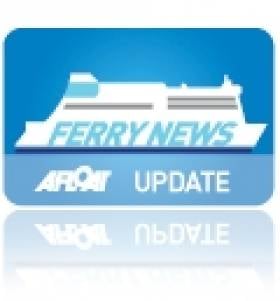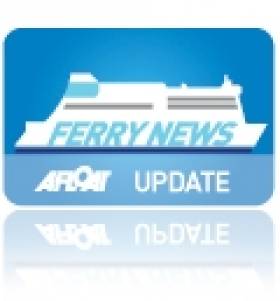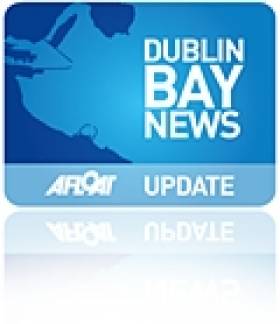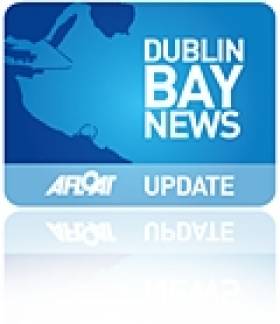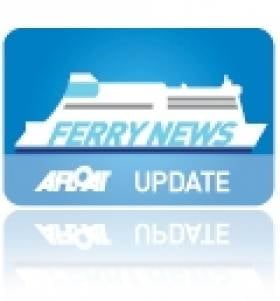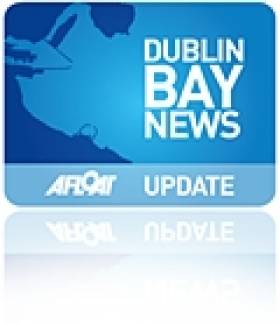Displaying items by tag: Dun Laoghaire Harbour News
HSS Sailings Coincide with Ferry Firm’s ‘Festive’ Foundation
#STENA LINE 50TH – The return today of Stena Line's HSS fastcraft festive-season Dun Laoghaire-Holyhead sailings, also marks the 50th anniversary of the Swedish-owned ferry company's maiden voyage 'Christmas Trips' across the Skagerrak, writes Jehan Ashmore.
The contrast could not be so stark between ferry operations of half a century ago and today. The inaugural sailing in 1962 saw the 350 (passenger-only) M/S Østersøen embark with Gothenburgers looking for alcohol, tobacco and food bargains in Skagen at the very northern tip of Denmark.
Present-day vessels on the Gothenburg route albeit to Frederikshavn, are operated by Stena Danica, Stena Jutlandica and HSS Stena Carisma, a smaller version of the revolutionary HSS Stena Explorer.
When the 1,500 passenger capacity catamaran HSS Stena Explorer was introduced on the Dun Laoghaire-Holyhead route in 1996, she was a technological breakthrough, using gas-turbine-powered engines. She also made maritime history as the world´s first (HSS) high-speed sea service ferry put into service and the fastcraft was designed to handle large articulated lorries.
Five decades later the vision and enterprise of founder Sten A. Olsson, remains firmly rooted and as the Stena Line brand which has a route network connecting eight countries, served by more than thirty vessels, and employing 5,700 people, in an area stretching between the Irish Sea and the Baltic.
HSS Fastcraft is Back for Christmas and Beyond
#HSS FASTCRAFT- Stena Line's HSS fastcraft as previously reported on Afloat.ie is to return to the Dun Laoghaire-Holyhead tomorrow, operating the 2hour 15 minute service on 12 selected days during the festive period.
Christmas Sailing Schedule: The fastcraft HSS Stena Explorer will operate sailings on the following dates: 20-23 December, 27-30 December and also early into the New Year between 2-5 January 2013. During these dates the HSS will operate one departure from Dun Laoghaire and Holyhead daily. For HSS sailing schedules and also on the Dublin-Holyhead route, click LINK.
2013 Sailing Schedule: The fastcraft HSS return's to open the 2013 main season on the Dun Laoghaire-Holyhead route starting 22 March. The service will continue through the high-season months and until 10 September.
Stena Line are the only regular commercial company operating out of Dun Laoghaire Harbour and where as previously reported on Afloat.ie the port in 2013, its second season in developing the cruise sector, is to attract 10 cruise callers including Cunard Line's Queen Mary 2 in mid-May.
Museum FUNdrasier: Crazy Bingo Night
#MARITIME MUSEUM – Help to raise funds for the National Maritime Museum in Dun Laoghaire as a Crazy Bingo Night with drag-queen Annie Balls is to take place on Saturday 17 November.
Will you be the lucky one to win a money prize or a Booby prize!...find out by attending the event held in the Sallynoggin Inn (doors open 8pm).
Tickets costing €10.00 include 5 games of Bingo and are available from the venue's off-license contact Tara or Katie on 01 214394 or from the museum on Haigh Terrace off Georges Street.
As for the museum which is mostly wheelchair accessible, visiting hours (Everyday) are 11am-5pm. Asides the many exhibits on display, there's a museum shop, a coffee dock and a Wi-Fi hotspot. For further information call 01 2800969 and www.mariner.ie
Stena Line's HSS Service Sounds Good for Lady Gaga
#LADY GAGA– Stena Line's HSS Stena Explorer is set to return to Dun Laoghaire Harbour this Sunday, despite last Tuesday's end of season sailings to Holyhead, as previously reported on Afloat.ie. The HSS has been specially chartered in to transport stage trucks following the Lady Gaga concert to be held this weekend in Dublin, writes Jehan Ashmore.
The US pop-star is to play her only Irish tour date on Saturday night in the Aviva Stadium. Following the New York musician's 'The Born This Way Ball' performance, the stage equipment is to be transported from the Ballsbridge venue by a convoy of 25 freight trucks to the ferryport in Dun Laoghaire for the sailing to Holyhead.
On arrival of the HSS into Dun Laoghaire, the fast-ferry will be in a 'light' mode, i.e. no passengers or vehicles on board. However on the return leg to Anglesey, the craft will be loaded with the stage trucks on the vehicle decks that are capable of loading in total 50 lorries (each of 15m in length).
Upon arrival in Holyhead, the truck convoy will travel 'landbridge' across the UK as they proceed onward to The Netherlands, where the tour continues in Amsterdam, at the cities Ziggo Dome.
However normal HSS sailings are to resume for 12 days over the Christmas /New Year period, for further information visit: www.stenaline.ie/ferry/book-now/hss-christmas-sailings-2012/
Shackleton Endurance Exhibition – ‘Triumph Against All Odds’
#SHACKLETON – A new exhibition telling the remarkable story of Sir Ernest Shackleton's Imperial Trans-Antarctic expedition of 1914-1917, was officially launched by the Tánaiste Eamon Gilmore earlier this week, writes Jehan Ashmore.
Among those attending the launch of Shackleton Endurance Exhibition in the Dun Laoghaire Harbour Ferry Terminal, were the Hon. Alexandra Shackleton, the only grand-daughter of the Kildare-born explorer, ambassadors from the UK, Australia and Canada, officials from the Dun Laoghaire-Rathdown County Council and the Dun Laoghaire Harbour Company, in which the exhibition is an initiative within the harbour's masterplan.
The exhibition relives the Irish-born explorer's story and his 28 men, where the rescue mission from the abandoning of the exploration ship Endurance, in the "terrible beauty" of the White Continent, is only today, rightly seen as perhaps the most remarkable in exploration history which is told through wall texts, diary excerpts and photographs taken by the expedition's photographer Frank Hurley.
The story explores the shift to living from the ship and onto the pack ice, their daily life in the various camps, the treacherous weather and near-total darkness of the Antarctic winter, their isolation on Elephant Island and their final, triumphant rescue and return.
A full size exact replica of the James Caird, the lifeboat that proved so critical to the rescue mission is on display. Tells of bravery and miraculous survival of its crew and of their faith in their expedition leader, Shackleton is a survival story like no other.
An insight into those who lived through the horrors of the expedition is examined, and of the three Irishmen, Shackleton, Tom Crean from Kerry and Tim McCarthy from neighbouring Cork.
The exhibition was originally curated in the American Museum of Natural History, New York in 2000 and has since toured extensively in America, Ireland, Spain and the UK. The current exhibition is held in association with the Royal Geographical Society (and IBG). For further information visit www.shackletonexhibition.com
Dun Laoghaire's Maritime Museum to Re-Open
#MARITIME MUSEUM-The much awaited re-opening of the Maritime Museum in Dun Laoghaire, Co. Dublin is to take place in April, writes Jehan Ashmore.
The museum which is near to Dun Laoghaire Harbour's East Pier, is to reopen on Tuesday 3rd April between 11am t- 5pm. Throughout the season, these same visiting hours apply Tuesdays to Sundays, though the museum will be closed on Mondays.
To read more about the initial exhibits on display (click HERE) in the apt surroundings of the former Mariners Church, where major and essentail renovation work took place over several years. The museum which is run by the Maritime Institute of Ireland (M.I.I.) celebrated its 70th anniversary last year and with the reopening they can now look forward to a new and exciting era.
Located on High Terrace, a Cul-de-Sac that links the town's main shopping thoroughfare on Georges Street Upper to The Metals, the pedestrian walkway –is only minutes away from the Dun Laoghaire DART station.
Car parking is limited in the immediate vicinity though there are car-parking facilities nearby in the Pavilion which is accessed along the harbour waterfront (Queens Road) and the Dun Laoghaire Shopping Centre approached from Marine Road.
In addition to visiting the museum the M.I.I. also welcome members and volunteers to assist in hosting lectures, producing newsletters, journals, a library, hosting and supporting commemorations in addition to conducting research and highlighting Irelands maritime heritage. For further information click HERE.
- Dublin Bay News
- Dun Laoghaire Harbour News
- Dun Loaghaire Harbour
- Mariners Church Dun Loaghaire
- Maritime Institute of Ireland (M.I.I.)
- M.I.I.
- Dun Laoghaire Shopping Centre
- Pavillon Car Parking
- The Metals
- Dun Laoghaire DART station
- Dun Laoghaire Harbour''s East Pier
- East Pier, Dun Laoghaire
- Irish maritime heritage
- Irish maritime museums
Dun Laoghaire Meeting also to Discuss Dalkey Oil Drilling
#DALKEY ISLAND PROSPECT – An urgent meeting to discuss calls for a public enquiry in respect to the Dalkey Island Prospect is to be held in Dun Laoghaire next Tuesday (31st January).
The meeting which is to address the serious environmental and public consultation concerns is to be held in the Royal Marine Hotel (7.30pm) and follows an 'information' meeting held earlier this week in Dalkey Town Hall.
At that meeting it was concluded with an almost unanimous agreement that a public enquiry should be held over the foreshore licence sought by Providence Resources to carry out exploratory drilling some 6kms offshore of the south side-suburb.
As reported previously on Afloat.ie, the chairman of the Dalkey meeting Bill Hastings, commented that the issue could divide the community and he said "many people pointed out that it was not just a Dalkey issue but one for all of Dublin Bay".
Screening to Mark ‘Mariners with Memories’
#MARITIME MUSEUM - A video recording of the 'Mariners with Memories" wreath-laying ceremony held at sea off Bray last year, is to take place tomorrow afternoon (at 14.30) in the maritime museum in Dun Laoghaire.
The ceremony which was held on 30 July involved a flotilla off Bray Harbour where floral tributes were made to commemorate all those lost at sea especially those whose last resting place is the sea which claimed their lives.
In addition the video presentation will also mark the 70th anniversary of the formation of Irish Shipping Ltd in 1941 and the founding of the Maritime Institute of Ireland (M.I.I.) which was also established in that year.
Copies of the D.V.D. will be available on request R.S.V.P. to this email: [email protected]
The institute aims are to foster an appreciation of the nation's maritime heritage and the museum which is located in the former Mariners Church. The museum has been closed for several years due to essential renovation, though is open on an invitation only basis during this winter. It is due to be officially re-opened in Easter of this year.
Activities of the M.I.I. (which is open to members) include running a winter/spring lecture programme, newsletters, a library, research and the hosting and supporting of commemorations.
For more information including how you can support them as a volunteer click HERE
Ferry Operator Consider Court Finding
#FERRY NEWS – Senior managers in Stena Line are considering today the implications of a Labour Court recommendation that it increase redundancy terms for 39 workers at its Dún Laoghaire Harbour operation, the Irish Times reports.
The Labour Court rejected the workers' claim for automatic redeployment from the Dún Laoghaire service to Stena's Dublin Port – Holyhead route operation.
Stena's Dublin Port operation is managed by a subcontractor RoRo Services Dublin Ltd, which Stena said had no vacancies.
The ferry company has said the Dún Laoghaire -Holyhead service, which is now seasonal, will reopen in April, as previously reported on Afloat.ie. However, the company told the Labour Court there is currently no work for staff in the south Dublin port.
Workers who are members of SIPTU have been seeking redeployment to Dublin Port or enhanced redundancy payments.
However, while the Labour Court did recommend enhanced redundancy payments, the enhancement is less than that sought by the workers.
In previous redundancies at the company offered three weeks' pay per year of service, inclusive of statutory redundancy. In addition, they had received ex-gratia payments of €18,000 plus an additional €500 per year of service. The Labour Court recommended the €500 per year of service payment should be increased to €1,050 per year of service.
The Labour Court recommended that the company confirm staff in Dún Laoghaire would be given first call on jobs when the Dún Laoghaire service resumes in April.
A Stena spokesperson said senior management at the company were considering the recommendation and would make a statement later in the day.
Portrait of R.M.S. Leinster Survivor to be Unveiled
#DUBLIN BAY NEWS-Tom Connolly, a survivor from R.M.S. Leinster which was torpedoed off the Kish Bank in 1918, will be remembered when his portrait is unveiled on 31 December.
The unveiling is to take place in the Dun Laoghaire Club, 1 Eblana Avenue, where live music will be the order of the night, starting at 8.30pm. Tickets costs €10 each and can be purchased from the club bar or Costello Jewellers on Cumberland Avenue. Proceeds will be used to provide wheel-chair access to the club.
R.M.S. Leinster was operated by City of Dublin Steam Packet Company (CDSPCo) and on the day of the incident she had 771 passengers (mostly military personnel) and crew on board. Of those 22 were postal sorters from the Dublin Post Office, working in the ships on postal sorting room. The prefix of the vessel, R.M.S. stood for Royal Mail Steamer.
Officially 501 people died, making it both the greatest ever loss of life in the Irish Sea and the highest ever casualty rate on an Irish-owned vessel, though research to date has revealed the names of 529 casualties. To read more click HERE.
Connolly was also a member of the Dun Laoghaire Club and he founded Ireland's first supermarket in Patrick Street, Dun Laoghaire. A model of R.M.S. Leinster was displayed in his supermarket over many years. The model is now in the town's National Maritime Museum of Ireland which is due to re-open in Easter next year, for further information www.mariner.ie



























